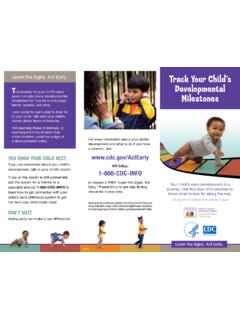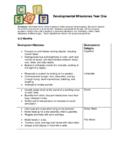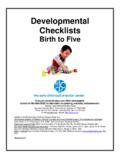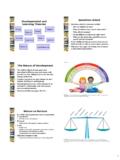Transcription of Developmental Scale for Children with Down Syndrome
1 DDeevveellooppmmeennttaall SSccaallee ffoorr CChhiillddrreenn wwiitthh DDoowwnn SSyynnddrroommee Thomas L. Layton, Extraordinary Learning Foundation T and T Communication Services, Inc. 100 Meredith Drive, Suite 100 Durham, NC 27713 Developmental Scale for Children with down Syndrome Thomas L. Layton, T and T Communication Services, Inc. 919-484-0012 Social and Communication Issues One of the most frequently asked questions by parents of Children with down Syndrome is how their child is doing compared to other Children with down Syndrome ? They are curious as to whether their child is keeping up with typically developing Children , but realize that it is more important to judge their child with other Children with a similar Syndrome .
2 To assist in the answer to this question, I have developed a Developmental Scale for Children with down Syndrome . The Developmental Scale provides the best information I know about young Children with down Syndrome seen in our clinic as well as what we have read in the literature. It also provides what typically developing Children demonstrate during infancy, toddler, and preschool ages. The Developmental Scale has not been scrutinized by colleagues or parents, and, therefore, provides only our best judgment of what can be expected. It is important to point out that all Children , even typically developing Children , do not look alike.
3 Each child is different and progresses at his or her own rate: each presents with particular strengths and demonstrates inherited weaknesses. This, of course, is the same for Children with down Syndrome . It is hard to just present a picture of what a child with down Syndrome looks like at a particular age. A lot depends upon the child s medical and health issues. For instance, has the child had a problem with hearing, especially middle ear pathology? If so, this can slow down or affect the development of speech production and expressive language.
4 Does the child demonstrate related difficulties such as autism? This clearly can affect the social interaction and rate of language acquisition. Does the child have a severe oral-motor problem? Again, this problem can delay speech production, can affect the quality of spoken speech, and can alter expressive language skills. It is important, therefore, for a parent to understand these issues when seeking information about what to for their child and what services are available. How a speech-language pathologist helps a child is clearly related to these and other social, cognitive, emotional, and health issues.
5 There are several publications available to help parents better understand these issues. It is not the intent to delve deeply into these areas, but instead to present the communicative skills of young Children with down Syndrome . Developmental Scale for Children with down Syndrome The Developmental Scale for Children with down Syndrome begins at Birth and increases in 4 months steps until age 24 months, at this point it progresses in 12-month steps. The Scale ends when the child is just turning 6 years of age (or 71 months). The reason for the difference in the early ages compared to the later ages is that younger Children , even Children with down Syndrome , progress more rapidly in the younger ages than they do in the older ages.
6 This is especially true for motor skills as well as language skills. Birth to 5 months During the first stage, Birth to 5 months, a parent can expect their child to react to a sound sometimes and not at other times. The reason for this is that the child may be congested with a middle ear fluid, or just may not be attending as readily to his environment. Inconsistent responses to sounds are a common occurrence at this age. Because of this, the child with down Syndrome may or may not turn his/her head toward the sound source and may or may not be watching the parents face when they talk.
7 It is strongly suggested that a child should be seen for an audiologic evaluation since it is well known that middle ear problems are common and Children with down Syndrome are more often prone to have a sensori-neural hearing loss. It is, therefore, important to have the child s hearing checked early. Children with down Syndrome seldom vocalize during the first 5 months of life, which often concerns parents. This concerns us too, but as long as the child s hearing has been checked and the child does not demonstrate oral-motor problems, it should not be too alarming.
8 Just keep talking to your child and read books together on a daily basis. Reading is an excellent teaching tool for speech, language, and cognitive development. We find many young Children , even 4 5 months of age, love to be read too. 6 10 months The Children during the second stage, or 6-11 months, begin to watch their parents face when being talk too and localize where a sound has come from, especially when the sound is sudden or unexpected. These Children notice their parents reprimands, such as, saying no-no ; but, understanding of words is not really expected yet.
9 Most Children with down Syndrome do not begin to babble or talk to themselves until around 10 months of age. Babbling is an important indicator as to how well the child is doing and whether he or she will be a talker later on, it helps to determine whether a child will or will not have trouble with spoken speech. Just because a child does not babble does not necessarily mean he or she will not talk later on. It may, however, indicate that more oral-stimulation and speech-stimulation is needed to assist the child in developing the needed movements for later speech productions.
10 11 15 months The Children at this age are beginning to show signs of language understanding. Parental reports of vocabulary development indicate that these Children demonstrate an understanding of about 20 words and try to communicate by looking at the parent, gesturing, or moving as if to say something. These Children want to communicate but the motor speech area in the brain is not developed sufficiently to allow for it. Thus, we encourage the use of manual signs to allow the Children to express his/her wants and needs. Oral-motor skills have improved so that now they can chew semi-solid foods, blow bubbles, and can stand up if allowed to hold onto something.







